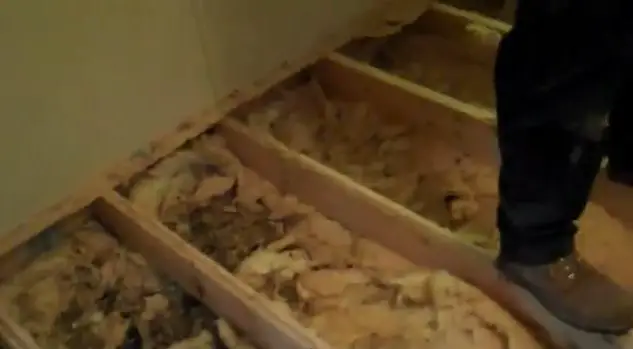This article originally appeared on Mobile Home Living on June 18th, 2014 by Crystal Adkins
You will probably need to replace the flooring in a mobile home eventually, especially if it’s an older home or you have encountered an unknown leak. For many years, mobile homes were constructed with sub-flooring made of particle board which essentially acts like a sponge – even a small amount of water can cause bowing, warping, rot, and soft spots.
Even in newer homes, where particle board wasn’t used, flooring can become warped or softened due to a small leak or routine encounters with water. Most newer homes now use a higher grade plywood or OSB because it can withstand water better. Still, if you have a soft spot or bowing in any area of your home it’s best to repair it quickly before it causes further damage. You don’t want the joists or walls to become damaged due to contact to the flooring.
Hopefully, this article will give you enough information to be comfortable with doing the job yourself. I’ll try my best to provide a step by step guide of the process and offer as many references as possible for further reading. Of course, if you have any questions feel free to add them in the comments and I’ll do my best to help.
Is Replacing Flooring in a Mobile Home Really a DIY Project?
Replacing mobile home flooring is not a terribly difficult DIY job. On a scale of 1 to 10, I would rank it a 7 because no specialty tools are required and the material list is short. It is a tedious job though because you are dealing with major components of your home and that’s always intimidating!
Your biggest concern will be avoiding joists, pipes, and wires – especially in a bathroom project. The most difficult parts of the job is removing the old flooring, building out the perimeter joists, and keeping everything level. We’ll deal with all of those issues in the step by step process.
Tool List
|
|
|
|
A circular saw is great because you can control the depth of the cut. If you have experience with circular saws or Sawzalls, you should do just fine. As stated above, one of the most tedious parts of replacing flooring in mobile homes is the removal of the original sub-flooring and the caution you’ll need to take so you don’t cut a joist.
Material List
|
|
|
|
You will need to measure your existing flooring to see if it is 3/4″ or 5/8″ thick (most are 3/4″). In addition to the screws, you will want to use a liquid nail or other construction adhesive between the joists and the new floor so it won’t squeak.
This is a great time to add new insulation between the joists. Every little bit helps!
Step-by-Step Process to Replace Flooring in a Mobile Home
Since I don’t have many photos, I’ve created the ‘quick and dirty’ list below of the basic steps to replace flooring in a mobile home. We’ll go over each process thoroughly below.

Step 1 – Remove the Trim and Floor Covering
The first step will be removing the trim and floor covering. If it’s carpet you will need to remove the strips. Vinyl will usually need to be cut around the parameter (perimeter) of the room and tile will need to be ripped up.
If a leak caused the damage, find it and repair so the same thing doesn’t happen to your new floor. With the covering removed you may be able to trace the leak better.
Step 2 – Cut the Sub-Floor Out Around the Perimeter of the Room
This is one of those tedious jobs no one likes to do! If your flooring is 3/4″ set your circular saw to that and follow the perimeter along the edge of the room. You do not want to touch the joists below.
Step 3 – Cut the Sub-Flooring Between the Joists
Now that you’ve cut the sub-flooring around the edges, you will need to cut them down so you can remove them. The smaller the pieces, the easier it is to get them out of your way. If you have ensured there are no pipes or wires between the joists you can simply saw between the joists and remove each piece. Remember to keep the saw set to the same thickness of the flooring to keep accidents to a minimum.
You may need to use a Dremel tool or knife to get the sub-flooring out from underneath the walls.
Step 4 – Inspect and Repair Joists
At this point, all the sub-flooring has been removed and you have a perfect opportunity to inspect the joists for any damage. If you do see damage you can reinforce it by adding an additional 2 x 4 to the original or removing and replacing. If there’s not much damage, reinforcing is probably easier.
Step 5 – Add Insulation
This is not necessary but it should be a top priority. Spending an extra $30 can save you a lot more in energy costs in the future. Remember, wiring and piping should be above the insulation so that the heat from the home can get to it.
Step 6 – Laying the New Sub-Flooring Down
The sub-flooring should be laid in the same direction as the original, usually opposite the direction of the joists. You will cut the plywood to the correct size to fit the necessary width of the room.
Around the perimeter of the room, you may need to attach an additional 2 x 4 to the original so that you have a shelf or lip to lay the new sub-floor down, then nail and glue.
At each seam, where one piece of plywood ends and another begins, you will need to reinforce under it. This means you will need to add a 2 x 4 between the original joists so you have a place to nail and glue down the plywood. You can see this happening in the photo above, where the small boards have been added between the long joists.
All the while, you want to make sure your floor is level. You can always add what you need to the joists or you can remove a bit if needed.
Step 7 – Install the New Floor Covering
Your choices are endless when it comes to floor covering. If it’s in a bathroom, it’s probably best you go with vinyl or tile – something with some protection against water will help protect your floor.
Step 8 – Enjoy Your New Floor
Congratulations! You did a fine job and it’s a great looking floor that will last for many years.







